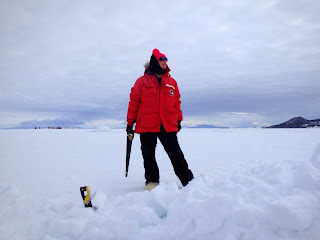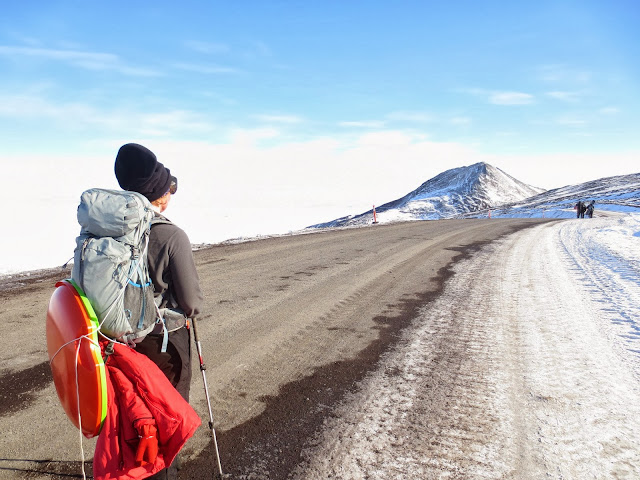Earlier this week I was given the opportunity to go on a trip. Before I go on I should give you a little vocabulary lesson.
Happy Camper: A two-day and one night training course that teaches you how to sleep out in Antarctica. It covers how to use the stoves they provide, the High Frequency radio, the survival bag, and the tents. They teach you how to sleep warm, secure your tent in high winds, build a snow wall and best methods for setting up camp.
Boondoggle: A field trip. Occasionally various work centers or scientists will need extra people to help them. When this happens, a call goes out to the work centers that are relegated to McMurdo station and supervisors will choose people from the crew to go and help. Boondoggles can be just for fun, but more often than not they are working trips. Examples include: Shannon's Happy Camper, Jamie's trip to the Dive Hut, helicopter trips to dig up fuel caches, twin otter trips to pack up field camps.
ECW: Extreme Cold Weather Gear. If you are told to bring your ECW is means to bring everything you were issued to keep warm. It is A LOT of clothes and most people don't ever wear it all. If you are you told to bring your ECW++ is means bring all your ECW and more. ECW includes your big red, overalls, bunny boots, googgles, and tons and tons of underlayers and various little extras like hats, balaclavas and liner layers.
Hagglund: A tractor. But it's really cute and people (myself included) really love them.
FSTP: Field Safety Training Program. These are also the people that go out and rescue you if you are trapped somewhere and the weather is turning bad, if you fall into a crevasse or have some other tragedy happen to you.
Got it all? OK.
Earlier this week my supervisor asked me if I wanted to go on a Happy Camper. Of course I said yes! Last year, everyone got to go but this year they are limiting it strictly to people who are actually going out into the field. After being canceled twice I finally made it out with Britt and Eric (both on my crew) and 6 other people (most of whom I knew). We showed up at the FSTP classroom at 8:30 and were walked though some basics for living and working in Antarctica: how to recognize hypothermia and how to help someone (or yourself) if you suspect it; How to make a realistic risk and hazards assessment of any task you are undertaking and, of course, group introductions.
After all this we loaded up our Hagglund and headed out to our campsite. Before we were allowed out into the wild, we were given some more prep. This time, more practical information. How to sleep warm, some basic orientation of the landscape and practice using the campstove.
Finally, we were brought out to our campsite, told to get our tools and then set to making a gear line. We were then walked though setting up tents in high winds, how to set a deadman anchor, how to build an snowwall and how to orient camp to protect you from high winds. The instructor walked us through these things but ultimately we did it on our own. She left us for the night after making sure we had our flag line set up (incase the weather got so bad we couldn't see), and our water was boiling for dinner (while she trusted us, she was clearly being cautious).
As a group we constructed the wind block and the kitchen and then we all sat around together to eat. It was really nice to be able to relax and chat with our group. Most of us were boondogglers used to fill out our group for the two scientists who were going to be flying out to camp the next day. It was fun to chat and get to know everyone.
After all the general camp activities were taken care of we were free to build our snow trench. Eric and I had already agreed to dig one together and I'm so happy we had decided that. It was, as you can imagine, hard work and lots of digging so it was nice to be able to switch out and have another person encourage you and give ideas. After digging for about 3.5 hours we decided, while it could be bigger, we were tired and ready for bed.
Climbing into the trench was an hilarious experience. The snow followed you into the trench and then into your sleeping bag. In fact, after getting into my bag, my hip was extraordinarily cold and after putting tons of layers on it I reached my hand into my pocket and found a snowballs worth of snow. Little things like that made it a real adventure to try and sleep warm. I was low-level chilly all night long but after using my Pee Bottle in the middle of the night and using the subsequent warm bottle for my toes I was able to sleep a little better. When 6:10am rolled around Eric woke me up a little too enthusiastically. I think he was really ready to get up and get out. Unfortunately, our trench JUST fit him so although his feet were inside his sleeping bag and had multiple layers, they were right up against the ice and so his toes were frozen in the morning. We took a few minutes to try and warm up his toes before climbing out and it was a good lesson for us on the little things that can keep you warm or make you cold. Thankfully it was a warm night in Antarctica-27 degrees and only 16 with windchill. In reality this is balmy weather for this continent and we were lucky it wasn't colder.
In the morning we ate breakfast and set about taking camp apart. It took us about two hours to get all the tents down, the gear put away and the trenches filled back in. When Jen came back with the Hagglund we were taking photos and singing sea shanties.
But our adventure with Happy Camper wasn't over yet! We went back to the warming hut to check in on everyone's night and if they stayed warm. We learned how to use the HF radio-we even got to call and talk to South Pole! We opened up a survival bag and walked though when and why you might need it. And we got to participate in the Bucket Head Scenario! Bucket head is an activity designed to simulate a white out condition and to get you to think about risks and hazards in going out to rescue someone caught in the storm. Thankfully our group had a rescue diver in it's midst and we decided our best chance of success was to send her out as she had experience being on a rope and in no-visibility conditions. In fact, we WERE successful in finding the last know location of our "missing member" but they had already left that location and we never found them before we were forced to begin our debrief. Overall, our group was great!
After Buckethead we had to clean up and head back to McMurdo. It was an excellent night out and one that I hope everyone gets to participate in as the season progresses!
 |
| In the Hagglund! |
 |
| It's a penguin! |
 |
| Did she let me drive this thing? |
 |
| Landscape orientation. |
 |
| Guess what these little things are. |
 |
| Learning about the camp stove. |
 |
| How to sleep warm. |
 |
| All our tools! |
 |
| What a gorgeous Gear line! |
 |
| Deb digging a snow trench! |
 |
| Building a snow wall! |
 |
| Testing the kitchen chairs. |
 |
| What great lighting and ventilation we had in our Kitchen. |
 |
| The whole crew! |
 |
| Me, Eric and Britt! Dinner time! |
 |
| Snow trench! |
 |
| Another version of a snow shelter. |
 |
| So Cozy! |
 |
| Are you Jealous? |
 |
| The next morning! |
 |
| Hagglund and gorgeous. |
 |
| Breaking down camp. |
 |
| Me and John at breakfast. |
 |
| The whole crew! |
 |
| Hagglund, me and Erebus. |
 |
| Talking about Bucket head. |
 |
| Radio Lingo. |
 |
| HF radio talk. |
 |
| Homemade radio antenae |
 |
| Setting up the antennae. do you see the bamboo poles? It's run up along those . |
 |
| Winding it out. |
 |
| Calling south pole! As our minimum temperature was 16 with windchill (and it wasn't really windy) we wanted to know what there's was. It was -27. I am SO HAPPY we are at McMurdo. |
 |
| Winding it back in. |
 |
| BUCKET HEAD! |
 |
| On her way to are a rescue! |
 |
| Our last photo before heading back. |
































































































